
We left the Amalfi
Coast, got on the autostrada and headed northwest. It was only 412 kilometers
to Perugia, our next destination. As we travelled from the province of
Campania, through Lazio (Rome) and into Umbria, the terrain underwent
some changes. Most notable were the pretty Umbrian hills and rolling countryside;
less pleasant were the deteriorating weather conditions. Our luck and
the sun had disappeared for the moment.
Perugia was a 7-6th Century BC Etruscan city-state before the Romans took over in 310 BC. It's a fascinating hill city, and large sections of massive Etruscan walls around it still exist. It's on several levels, and has a confusing layout. We did pretty well — finding our way to the hotel by spiraling upward. From then on, our two days in the city were spent on foot.
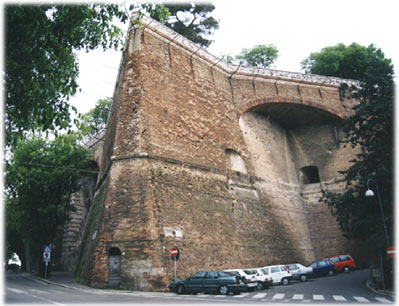 Down
the street from our hotel we entered a tunnel ... then took a series of
underground escalators up,and up, through the remains of a 1540 fortress,
Rocco Paolina. There are still old cobblestoned streets and original walls
in this unusual place. There were also some modern additions, like gift
shops, in the subterranean enclave.
Down
the street from our hotel we entered a tunnel ... then took a series of
underground escalators up,and up, through the remains of a 1540 fortress,
Rocco Paolina. There are still old cobblestoned streets and original walls
in this unusual place. There were also some modern additions, like gift
shops, in the subterranean enclave.
We emerged at the Piazza Italia and walked down Corso Vannucci. On the left was the Palazzo dei Priori, a huge Italian Gothic building which houses a library and on the third floor, the Galleria Nazionale dell'Umbria. In it are large paintings and frescoes by Perugino (a local master), Pinturicchio, della Francesca, and Fra Angelica to name a few, representing Umbria art from the 13C to 18C. The subject matter was almost exclusively the Madonna and child. I have to say these styles — very stilted; and the imagery — very austere; were not my taste, but the talent of the artists was evident.
At the end of Corso
Vannucci is Perugia's main square, Piazza IV Novembre. At its center is
a beautiful circular fountain — Fontana Maggiore — with reliefs
sculpted by Nicola and Giovanni Pisano. Behind the fountain is the Cattedrale
di San Lorenzo.
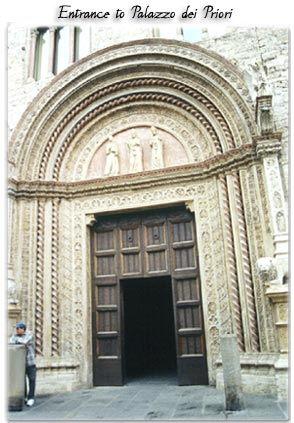 |
 |
 |
|
![]() Inside
a small chapel away from the Piazza, we found another example of Perugino's
work, similar to those in the Museo. A wall fresco, and a "collaboration"
with Raphael.
(click for larger view)
Also in this area we discovered an Etruscan well in the bowels of an old building. Very deep and
spooky, with a creaky catwalk across its diameter.
Inside
a small chapel away from the Piazza, we found another example of Perugino's
work, similar to those in the Museo. A wall fresco, and a "collaboration"
with Raphael.
(click for larger view)
Also in this area we discovered an Etruscan well in the bowels of an old building. Very deep and
spooky, with a creaky catwalk across its diameter.
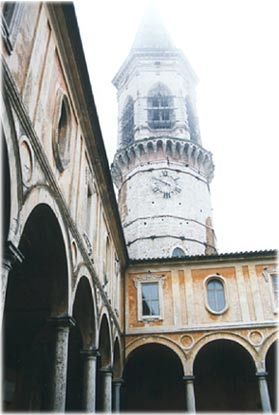 Walking
the streets of Perugia in the rain gave it an even more medieval feeling.
And it was a good excuse to visit the Museo de Archeologico, south on
the Corso Cavour. Between this collection, Pompei and other cathedrals
and museums in Italy, I'd never seen so many sarcophagi and funerary monuments.
The afterlife was very much on the mind. Further along Corso Cavour was the Porta San Pietro, a 14th C gated archway
that crossed the narrow roadway; at the end of the road was the fog-shrouded
belltower of San Pietro. The church's courtyard was surrounded by columned
arches, and we stepped inside quietly (a service was in progress) to see
the laboriously carved wooden choir stalls (mid-14th C).
Walking
the streets of Perugia in the rain gave it an even more medieval feeling.
And it was a good excuse to visit the Museo de Archeologico, south on
the Corso Cavour. Between this collection, Pompei and other cathedrals
and museums in Italy, I'd never seen so many sarcophagi and funerary monuments.
The afterlife was very much on the mind. Further along Corso Cavour was the Porta San Pietro, a 14th C gated archway
that crossed the narrow roadway; at the end of the road was the fog-shrouded
belltower of San Pietro. The church's courtyard was surrounded by columned
arches, and we stepped inside quietly (a service was in progress) to see
the laboriously carved wooden choir stalls (mid-14th C).
![]() We
walked the northern section of Perugia also, toward the University, a
well-known school for foreign students. On the way, and around every bend
we enjoyed the wonders
and beauty of Perugia: arches, niches, stairways, buildings and viewpoints.
This was historic Italy at its best and most fascinating.
We
walked the northern section of Perugia also, toward the University, a
well-known school for foreign students. On the way, and around every bend
we enjoyed the wonders
and beauty of Perugia: arches, niches, stairways, buildings and viewpoints.
This was historic Italy at its best and most fascinating.
One especially stunning sight was the Oratorio di San Bernardino (below). Designed by Agostino di Ducci in 1461, the soft colors of the marble, the lines, reliefs, inlays and the cobblestones in front — exquisite.
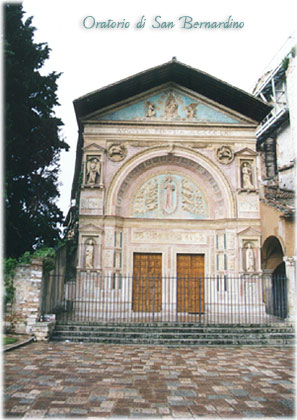 |
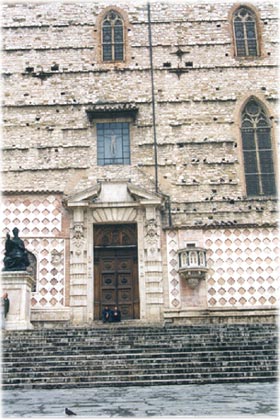 |
And happily, we even found a trattoria at which to have an "early" dinner. I never expected to be so hungry, so often, while we were in Italy (quite the opposite!). But, because of the lifestyle — large, long midday meals and a business shutdown in the afternoons, dinner was a late-arriving event. Most restaurants didn't open until 7:30, or later. This, along with our habit of skipping a regular lunch because we were too busy doing and seeing, meant certain discomfort for early-dinner-eater me.
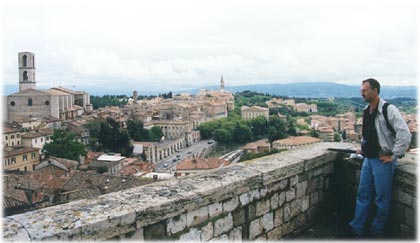 Nearing
the end of our stay, we spent some time in a well-stocked bookstore, finding
wonderful books, calendars and posters. One more spin around the Piazza
IV Novembre, and then back to the best
vantage point in Perugia for a last look.
Nearing
the end of our stay, we spent some time in a well-stocked bookstore, finding
wonderful books, calendars and posters. One more spin around the Piazza
IV Novembre, and then back to the best
vantage point in Perugia for a last look.
From Perugia it was only a short drive east to Assisi. Though it was still raining steadily, it was a memorable stop — the Basilica was one of the most magnificent we would see, and on the lower level was the tomb of St. Francis.
Time to backtrack to the west; we were headed for Tuscany next ...
Roma • Roma2 • Roma3 • Vesuvio & Pompei • Sorrento to Amalfi Coast • Capri
Amalfi Coast • Perugia • Siena & Toscana • Firenze • Firenze2
© 2001 CCarnovale Home | Web Design | Graphics | Photos | Travels